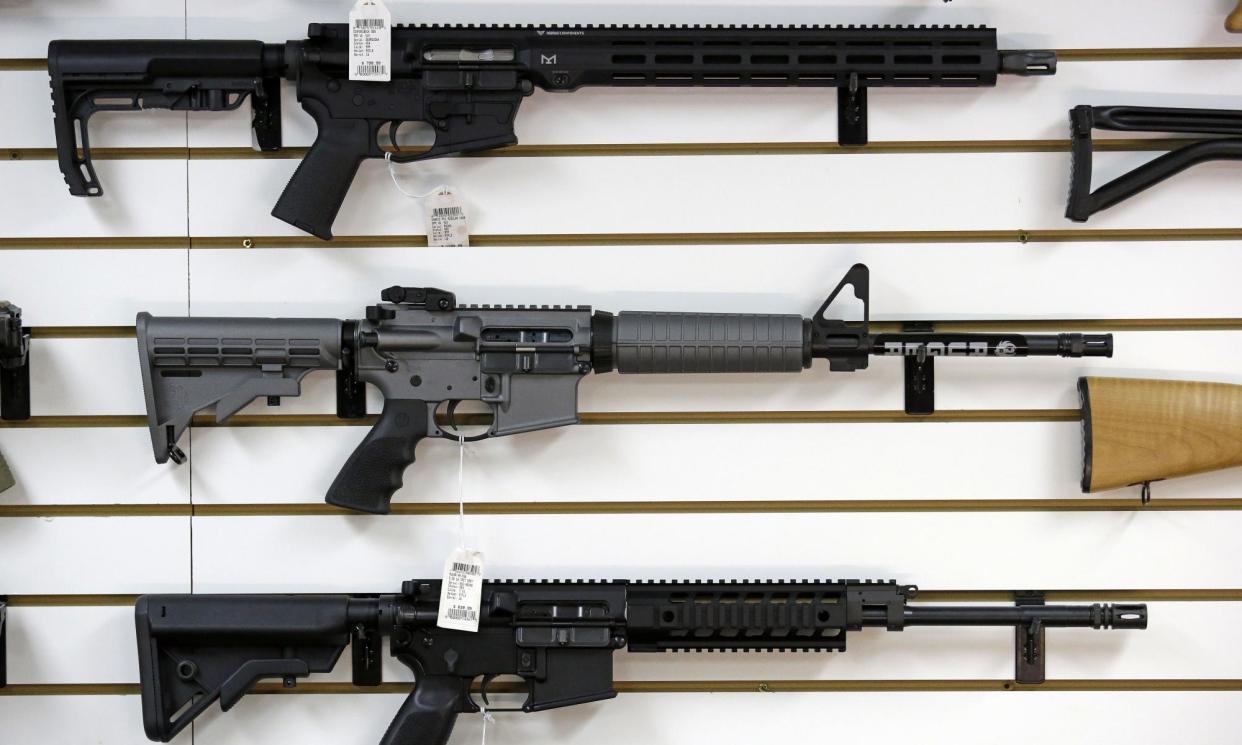Guns and weapons trafficked from US fueling Haiti gang violence

As Haiti has again plunged into violent chaos, images of gang members bearing high-powered rifles, pump action shotguns or automatic weapons in the streets of Port-au-Prince have become ubiquitous.
But this weaponry is not made in Haiti, a country with no firearms or ammunition manufacturing capabilities.
It is an arsenal that largely comes directly from the US, with most guns, experts say, likely to have originated from states with lax firearm laws, and many trafficked into Haiti from Florida.
Related: Haiti: what caused the gang violence and will it end now the PM has quit?
This clandestine trade has left Haiti’s gangs with a vast cache of illegal arms and much greater firepower than the country’s dispirited and underfunded police force.
A 2020 estimate published by Haiti’s disarmament commission estimated there could be as many as 500,000 small arms in the country, with just 38,000 of those legally registered. The number, analysts say, is now likely to be even higher following an uptick in trafficking operations in recent years.
A large portion of these, said Robert Muggah, a security expert and co-founder of the Igarapé Institute security thinktank, are obtained in the US by straw purchasers (buyers who obtain the guns on behalf of the smugglers). The weapons are largely bought in states with weak gun regulations like Florida, Arizona, Texas and Georgia.
“Easily accessible firearms from the US are one of several factors that are deepening Haiti’s instability,” Muggah said. “The abundance of high-powered rifles, handguns and ammunition is dramatically amplifying the power of criminal gangs who easily outgun Haiti’s depleted national police and modest security agencies. They are also playing a key role in driving-up high rates of sexual violence, violent assaults, kidnapping and internal displacement.”
A number of recent seizures have laid bare the relative ease with which traffickers operate. In February, US prosecutors secured guilty pleas for two senior members of the 400 Mawozo – the gang which became internationally notorious with a 2021 kidnapping of 17 Christian missionaries from Ohio who were visiting an orphanage in Port-au-Prince.
Investigators discovered an arsenal of at least 24 firearms including AK-47s, AR-15s, an M4 Carbine rifle and a military grade .50 caliber sniper rifle, following purchases at several gun shops in the Florida cities of Miami, Orlando and Pompano beach, according to an unsealed indictment.
Joly Germine, a 31-year-old leader of 400 Mawozo, directed specific requests for high powered weapons via WhatsApp messages sent from Haitian prison. The requests were made to US citizens in Florida, including Germain’s romantic partner, and the weapons were then stuffed in garbage bags, loaded into large barrels and hidden under “clothes, shoes and Gatorade” ready for shipment.
To the extent that the traffickers succeed, it is because of the massive volume of goods that move across borders
Matt Schroeder
In July 2022, authorities in Haiti seized a haul of 17 semiautomatic weapons, a 12 gauge shotgun, four pistols and 15,000 rounds of ammunition stuffed in a shipment from Florida and bound for a Haitian Episcopal church, which enjoys certain customs exemptions.
“None of the smuggling techniques or concealment methods are innovative, unique or require expertise,” said Matt Schroeder, a senior researcher at Small Arms Survey. “To the extent that the traffickers succeed, it is because of the massive volume of goods that move across borders and the difficulty of thoroughly screening every shipment.”
US authorities have made efforts to ratchet up enforcement in recent years, including expanding Homeland Security operations in Florida, the creation of a new regional taskforce with other Caribbean community states, as well as harsher punishments for straw purchases included in bipartisan gun laws from 2022.
But, said Muggah, the results, while making some headway, are likely only scratching the surface.
“It is widely assumed that authorities in both countries are only seizing a fraction of the total volume of firearms and ammunition entering the country, either by land, air or sea,” he said.
Crucially, the Haitian government’s customs and border forces remain chronically under-resourced. A recent report published by the UN’s office on drugs and crime found that Haiti’s national police border patrol unit has just 294 officers, while the country’s coast guard has only 181 personnel and a single operational vessel. Haiti has 1,770 km of coastline and a 392 km land-border with the Dominican Republic.
Related: ‘Women’s bodies weaponized’: Haiti gangs use rape in spiraling violence
As a result there has been a proliferation in routes of illegal arms traffic, according to a number of recent UN security council reports reviewed by the Guardian. These include shipments from Florida into Port-au-Prince and to the northern cities of Port-de-Paix and Cap-Haïtien, and land smuggling routes over the border with the Dominican Republic following shipments made to two key ports.
UN researchers have also identified 11 clandestine airstrips throughout the country, many of which were developed for humanitarian purposes following a catastrophic earthquake in 2010 but are now barely monitored. Some, according to satellite images referred to in the report, are contained “within large private properties”.
The UN security council report, published in January, cautions that there are as many as 30 US registered private aircraft based in Haiti, which are difficult to track if they travel below 18,000 feet as Federal Aviation Administration regulations mean they do not require official flight plans.
“The reality is that so long as there is high supply and demand for firearms and ammunition, they will continue to be trafficked from the US to its neighbors, including in Haiti,” said Muggah. “This is not just because of the tens of thousands of firearms retail outlets in the US, but also the persistent appetite from the hundreds of criminal gangs across the Caribbean.”


